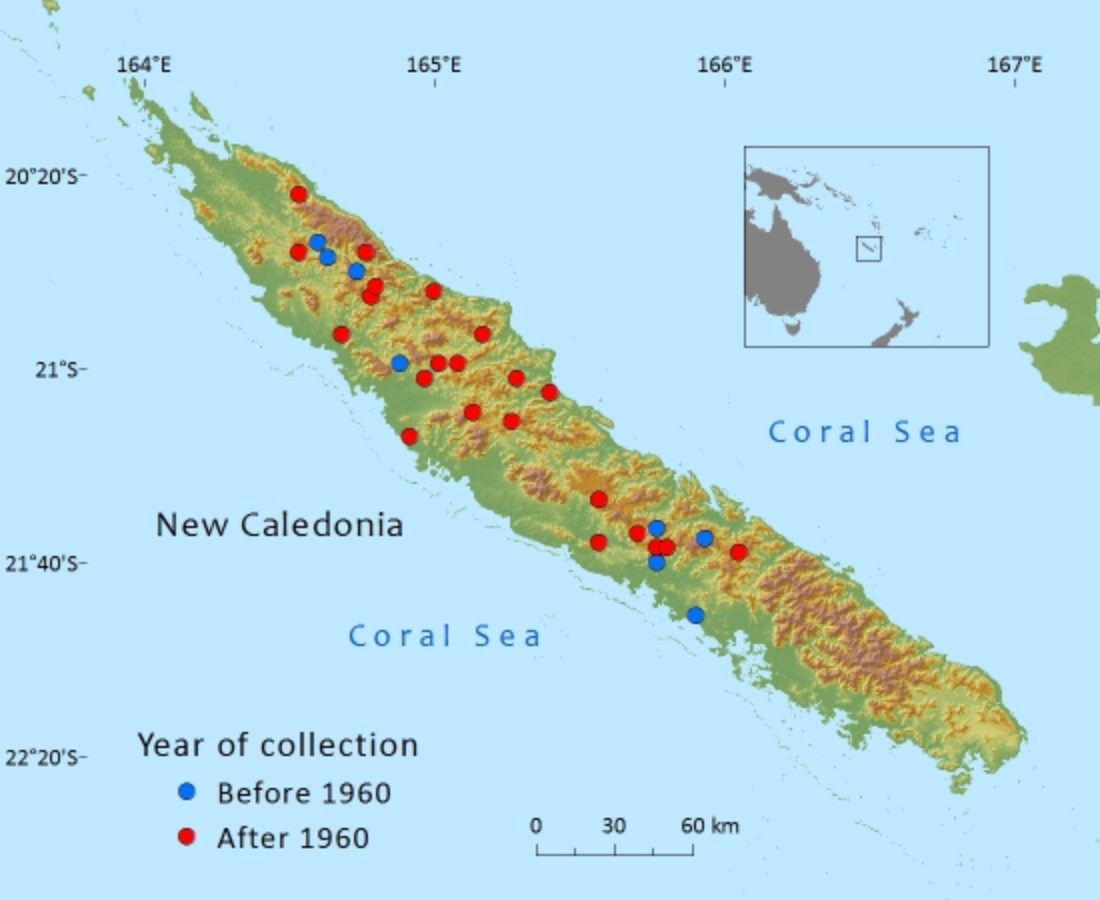Araucariaceae
Agathis moorei
One of four Agathis species endemic to New Caledonia where it once had a widespread distribution on the mian island of Grande Terre but is now much reduced due to logging and landuse change.
Description
Habit
Tree 30‒40m tall and 1m d.b.h., with a clear cylindrical bole to 18m; crown conical or rounded, becoming more open and irregular when mature. Bark smooth or rough with exfoliating scales peeling in irregular flakes, grey when mature.
Foliage
Leaves (mature) almost opposite, narrowly ovate-elliptic, 4.5‒7 x 0.8‒1.2cm leathery, multiveined, glabrous, apex obtuse, pale green or glaucous.
Cones
Male pollen-cones axillary, solitary, cylindrical, 2.5‒3 x 0.6‒0.9cm, with 4-8 pairs of overlapping bracts at their base, each pair at right angles to the pair next above or below, peduncles thick, 8‒12mm. Female seed-cones solitary, globose,10‒15 x 9‒12cm , green or glaucous green, brown when mature, very resinous. Seeds 15‒20 x 8‒10mm, with two unequal wings.
Taxonomic note
In this assessment, Agathis corbassonii is included with A. moorei. A. corbassonii was originally segregated on the basis of its very reddish brown bark and its narrow leaves which are often glaucous beneath. However, a recent revision (T.G. Waters, unpublished D.Phil thesis, Oxford 2008) strongly indicates that these characters are related to environmental conditions. Other characters such as numbers of bract scales in pollen cones fall within the range of those described for A. moorei (Farjon, 2010).
References and further reading
- de Laubenfels, D.J. (1972). Flore de la Nouvelle-Caledonie et Dependances. (4). Gymnospermes. Paris: Museum National d'Histoire Narurelle. 167 pp.
- Jaffré, T., Munzinger, J. & Lowry, P. P. (2010). Threats to the conifer species found on New Caledonia's ultramafic massifs and proposals for urgently needed measures to improve their protection. Biodiversity and Conservation: 19(5):1485-1502.
- Jaffré, T., Bouchet, P. & Veillon, J.-M. (1998). Threatened plants of New Caledonia: Is the system of protected areas adequate? Biodiversity and Conservation 7(1): 36.
- Manauté, J., Jaffré, T., Veillon, J.-M. & Kranitz, M. (2003). Revue des Araucariaceae de Nouvelle-Calédonie. IRD, Nouméa.
- Nasi, R. (1982). Essai pour une meilleure connaissance et une meilleure comprehension des Araucariacées dans la végétation Calédonienne. Nouméa: École Nationale des Ingénieurs des Travaux des Eaux et Forêts, Centre Technique Forestier Tropical. 134 p., 10 plates, 44 p. appendices.
- Suprin, B. (2011). Florilège des plantes en Nouvelle-Calédonie angiospermes ou plantes à fleurs (lauracées à zingibéracées). Tome 1. Nouméa: Éditions Photosynthèse, 519 pp.
- Thomas, P. (2010). Agathis moorei. In: IUCN 2012. IUCN Red List of Threatened Species. Version 2012.1. ww.iucnredlist.org. Downloaded on 29 June 2012.
- Whitmore, T. C. (1980). A monograph of Agathis. Plant Systematics and Evolution 135: 41-69.
